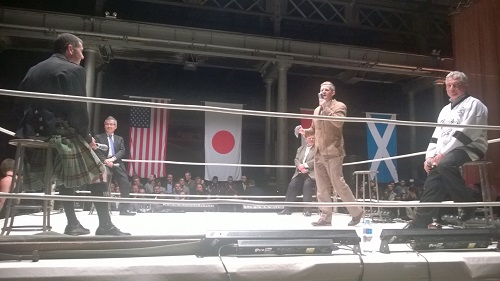By Andy Young
Last night saw four whisk(e)y greats from around the world gather in Sydney for the Great Whisk(e)y rumble, hosted by Beam Suntory.
Fred Noe, seventh generation master distiller of Jim Beam, John Campbell, distillery manager of Laphroaig, Dan Tullio, Canadian Club whisky master ambassador and Hiroyoshi (Mike) Miyamoto, Suntory Whisky global brand ambassador, all gathered to "rumble" and debate who makes the world's best whisk(e)y.
The rumble took guests on a journey through the four whiskies, with the four representatives sharing their views and personal experiences of their brands. The event saw each person making their point from inside a boxing ring, to give it that real rumble feel.
Dan Tullio highlighted the heritage of Canadian Club, saying the brand “truly has a rich history, we date back to 1858. It started out with our founding father Hiram Walker, at the age of 40 he decided that he wanted to make whisky. He didn’t want to do it in the US because he felt there was a temperance movement, so he looked towards Canada.
“To stay alive and well in this industry you have to be innovative, so Canadian Club is our standard brand and is available in over 150 countries around the world and thank you Australia for being our number three market in the world.”
Tullio presented Canadian Club 12-year-old for tasting, which he described as the “premium brand in the eyes of Canadian whisky. It is aged in freshly dumped, recharred Jim Beam barrels, this means we can take the softer spices from those barrels.”
Noe presented Jim Beam’s Devil’s Cut, which he explained comes from sweating Jim Bourbon barrels. “The wood holds around two gallons of whisky and during the aging it moves in and out of the wood with the hot summers and cold winters. As the whisky passes through the caramelised layer of sugar during aging, that’s where we are getting our colour and flavour from.
“When we dump the Bourbon from the barrel, there’s still two gallons of whisky in that wood. Water can draw that whisky out of the wood and we call that sweating a barrel. We dump the Jim Beam out of the barrel and we come back with 60 litres of water and put it back into that 200 litres barrel, then we put it in a shaker for about 45 minutes. Then we take the barrel off the shaker, take that water out of the barrel, filter out all the charcoal and then use that water to cut the barrel strength six-year-old Jim Beam down to 45 per cent and that gives more tannin to the whisky.
“We got the name because we lose about four per cent of whisky to evaporation and that’s called the Angel’s Share and so we thought we’d call what’s left in the wood the Devil’s Cut.”
Miyamoto’s challenge came via Hibiki Japanese Harmony, which uses Japanese oak, “that signature is the character of Hibiki,” Miyamoto said.
He added: “Last year we launched the Harmony, our chief blender when he created Hibiki Japanese Harmony did not think of the original Hibiki 17-year-old at all. But after he created Harmony he looked up the recipe for the orginial Hibiki and they were almost identical. He was amazed. We believe that Hibiki Japanese Harmony is the original start of Hibiki’s expression, although this is in fact the last one we launched to market.
“This is a perfect introduction to the luxury category of Japanese whisky, perfect for those who haven’t tasted whisky before. It is very versatile and I hope the Australian people love it.”
Finally Laphroaig’s John Campbell presented his 15-year-old whisky, a limited expression which was released to commemorate the distillery’s 200-year anniversary.
Campbell explained that the distillery used to make the 15-year-old but several years ago decided to go with 18-year-old Laphroaig and discontinue the 15-year-old. But nostalgia kicked in and people started asking for the 15-year-old again, so “we thought the first liquid we would release in out bi-centenary would be the 15-year-old.
“We made it in the same way we did previously, but this is in a smaller batch this time round, so it is going to taste a bit different. What I like about this whisky is that normally with Laphroaig the flavours are compartmentalised. So you’ll get wave after wave of flavour, but this one flows all the way through your tongue. So it is going to flow from the front to the back of your tongue, you’ll find in the middle of your tongue you get spices and then the peat comes at the back of your tongue, it just flows all the way through.”
The event concluded with a range of cocktails for guests, who then debated which region they believe produces the world’s best whisky.

